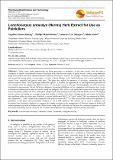Lonchocarpus eriocalyx (Harms) Herb Extract for Use as Painkillers

View/
Publication Date
2020-02-02Author
Atieno Ochung, Angeline
Okinda Owuor, Phillip
Arot Manguro, Lawrence
Ishola, Ismael
Metadata
Show full item recordAbstract/
Today, many herbal preparations are being prescribed as analgesics. In the past decade, there has been a
resurgence of interest in traditional systems of medicine which has become a topic of global interest. Indeed, many important
drugs in the market have been obtained directly/ indirectly from natural sources, for example: morphine, pilocarpine, quinine
and artemisinin among others. Lonchocarpus eriocalyx (Harms) belongs to the family Fabaceae and is used traditionally to
control fever, headache and general body pain. This plant was studied for presence of secondary metabolites and the
antinocieceptive effects. Four lupane-type terpenoids; lupeol (1), friedelin (2) stigmasterol (3), and stigmasterol glucoside (4)
were isolated from the ethylacetate (EtOAc) extract of leaves by extensive silica gel chromatography and their structures
elucidated by spectroscopic 1D and 2D Nuclear Magnetic Resonance (NMR) as well as comparison with literature data. Acetic
acid-induced writhing test in mice was used to study the analgesic effect of the crude extract and isolates with Acetyl-salicylic
acid as the positive control (87.37%). After prior intraperitoneal injection (i.p) of the mice with the EtOAc extract (100 mg/Kg)
and the isolates (10 mg/kg, p.o.), comparatively less number of writhes were observed implying that the extract and isolates
had significant ability to relieve pain. Similarly, a percent inhibition of 50.52, 76.7, 66.47 and 62.24% was observed in EtOAc
and compounds 1, 2 and 3 respectively compared to the positive control (87.37%). This research has confirmed the presence of
painkillers in this plant and scientifically validates its use in folk medicine. The isolates can be used as templates and
derivatised into alternative analgesics to support the existing strategies in the management of diseases. Improved health will
enhance productivity both at National and Global levels. Large scale cultivation of this plant for commercial purposes will be
an Income Generating Activity (IGA) for the rural poor and supplement the strategies aimed at poverty alleviation.
Collections
- Department of Botany [232]
